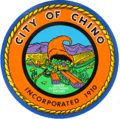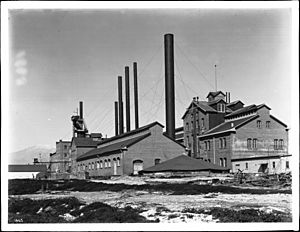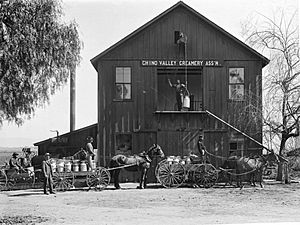Chino, California facts for kids
Quick facts for kids
Chino, California
|
|||
|---|---|---|---|
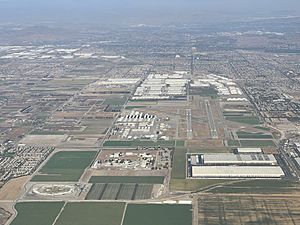
Chino Airport in 2021
|
|||
|
|||
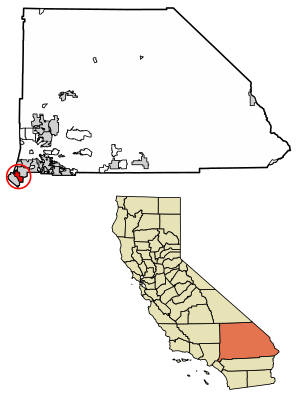
Location of Chino in San Bernardino County, California
|
|||
| Country | |||
| State | |||
| County | San Bernardino | ||
| Incorporated | February 28, 1910 | ||
| Named for | Rancho Santa Ana del Chino | ||
| Government | |||
| • Type | Council–manager | ||
| Area | |||
| • Total | 29.70 sq mi (76.93 km2) | ||
| • Land | 29.61 sq mi (76.68 km2) | ||
| • Water | 0.10 sq mi (0.25 km2) 0.04% | ||
| Elevation | 728 ft (222 m) | ||
| Population
(2020)
|
|||
| • Total | 91,403 | ||
| • Estimate
(2023)
|
93,114 | ||
| • Rank | 81st in California | ||
| • Density | 3,087.42/sq mi (1,192.05/km2) | ||
| Time zone | UTC-8 (Pacific) | ||
| • Summer (DST) | UTC-7 (PDT) | ||
| ZIP codes |
91708, 91710
|
||
| Area code | 909 | ||
| FIPS code | 06-13210 | ||
| GNIS feature IDs | 1660477, 2409453 | ||
Chino (pronounced CHEE-noh) is a city in San Bernardino County, California. It's located in Southern California, close to Los Angeles County and Orange County.
Chino has a long history of farming and dairy farming. It has provided milk and other farm products to Southern California for many years. The city's farming roots go back to a Spanish land grant called Rancho Santa Ana del Chino.
Chino is surrounded by other cities like Chino Hills, Pomona, and Ontario. It's easy to reach by major freeways. In 2020, about 91,403 people lived in Chino.
Contents
What Does "Chino" Mean?
The name "Chino" comes from the land grant where the city was founded, called Rancho Santa Ana del Chino. "Santa Ana" means Saint Anne in Spanish.
The meaning of "Chino" itself has a few ideas. One idea is that "Chino" (which can mean "curly-haired person" or "mixed-race person" in Spanish) was the name of a local Native American leader. Another idea suggests it refers to the "curl" at the top of a type of grass called grama grass, which grew a lot in the valley.
Chino's History
Early Days and Spanish Influence
Long ago, the Tongva lived in this area. They had a settlement called Wapijangna near the Santa Ana River. Later, some of them were baptized at Mission San Gabriel, which was built in 1771. The land was first claimed by Spain, then by the Mexican government after Mexico became independent.
The Rancho Era
Around 20 years later, the Mexican governor gave the land of Rancho Santa Ana del Chino to Antonio Maria Lugo. Later, his son-in-law, Isaac Williams, took over the rancho. Williams raised many horses and cattle. This attracted people who wanted to steal animals, including a Ute leader named Walkara.
During the Mexican–American War, a fight called the Battle of Chino happened at Williams' rancho. After the battle, a group called the Mormon Battalion helped with farming and built a mill there.
Gold Rush and City Growth
When the California Gold Rush started, the rancho became a popular stop for travelers. Coal was also discovered there. In 1850, California became a state.
Later, Richard Gird bought the rancho. In 1887, he divided the land, and it became the "Town of Chino." It officially became a city in 1910. Farmers grew sugar beets, corn, and alfalfa.
The Chino Valley had very rich soil, making it a great place for farming from the 1890s to the mid-1900s. Sugar beets were important early on, followed by sweet corn (known as "Chino corn"), peaches, walnuts, tomatoes, and strawberries. The city's official symbol even has a cornucopia, a symbol of plenty.
From the 1950s to the 1980s, the dairy industry grew a lot. Many Dutch families moved to Chino because the city had rules that helped dairy farms. Chino became one of the biggest milk-producing areas in California, which is the largest milk-producing state.
Chino Today
Because of its farms and open spaces, Hollywood often filmed movies and TV shows in Chino. In the 1960s, parts of Bus Riley's Back in Town and the TV series Twelve O'Clock High were filmed here. Chino's airport was even made to look like a British airfield!
In the 1970s, Chino started to grow into a small suburb. Today, it's a developed city with many businesses and some remaining farms with animals like goats and chickens.
Economy in Chino
Chino has many different types of businesses. Here are some of the biggest employers in the city:
| # | Employer | # of employees |
|---|---|---|
| 1 | Chino Valley Unified School District | Over 1,000 |
| 2 | California Institution for Men | Over 1,000 |
| 3 | California Institution for Women | 500–1,000 |
| 4 | Chino Valley Medical Center | 500–1,000 |
| 5 | Wal-Mart | fewer than 500 |
| 6 | Hussmann | fewer than 500 |
| 7 | Best Buy | fewer than 500 |
| 8 | Nature's Best | fewer than 500 |
| 9 | Mission Linen Supply | fewer than 500 |
| 10 | Target | fewer than 500 |
| 11 | Omnia Furniture | fewer than 500 |
| 12 | AEP Industries | fewer than 500 |
| 13 | J. C. Penney | fewer than 500 |
| 14 | Farmers Insurance Group | fewer than 500 |
| 15 | ClosetMaid | fewer than 500 |
Chino is also home to two large state prisons for adults: the California Institution for Men and the California Institution for Women. There is also a youth correctional facility. These facilities are major employers in the city.
Education in Chino
Chino is part of the Chino Valley Unified School District.
Elementary Schools
Chino has several elementary schools, including:
- Alicia Cortez Elementary
- Newman Elementary
- E.J. Marshall Elementary
- Dickson Elementary
- Anna Borba Fundamental
- Howard Cattle Elementary
- Edwin Rhodes Elementary
- Walnut Avenue Elementary
- Liberty Elementary
Junior High Schools
There are four junior high schools in Chino:
- Briggs Junior High School
- Ramona Junior High School
- Magnolia Junior High School
- Woodcrest Junior High School
High Schools
Chino has three high schools:
- Don Lugo High School
- Buena Vista High School
- Chino High School
Other Schools
Chino also has some K-8 schools, which teach students from kindergarten through 8th grade. These include:
- Lyle S. Briggs Fundamental School
- Cal Aero Preserve Academy
- Legacy Academy
For students who want to continue their education after high school, Chino has a satellite center of Chaffey College, which is a community college.
Geography and Climate
Chino covers an area of about 29.7 square miles (76.9 square kilometers). Most of this area is land.
Location
Chino is a suburb in San Bernardino County. It is about:
- 33 miles (53 km) from San Bernardino (the county seat)
- 35 miles (56 km) from Los Angeles
- 26 miles (42 km) from Riverside
- 30 miles (48 km) from Santa Ana
- 24 miles (39 km) from Anaheim
Weather in Chino
Chino has a Mediterranean climate. This means it has long, hot summers. The mornings are usually cool or mild. Winters are short, mild, and wet, with chilly mornings. Most of the rain falls in February.
Population of Chino
Chino has grown a lot over the years.
- In 1930, there were 3,118 people.
- By 1970, the population grew to 20,411.
- In 2000, it was 67,168.
- In 2020, the population reached 91,403.
The city is home to people from many different backgrounds. In 2020, about 51% of the population was Hispanic or Latino. About 20% were White (not Hispanic), and about 19% were Asian.
Transportation
The Chino Transit Center is a main hub for buses. From there, you can take Omnitrans buses to places like the Montclair Transcenter. At Montclair, you can connect to Metrolink trains and other buses to reach downtown Los Angeles and other cities.
Famous People from Chino
Many talented people have come from Chino, especially athletes:
- Brent Billingsley, MLB player
- Chris McFoy, NFL player
- Diana Taurasi, a famous basketball guard for the Phoenix Mercury
- Esera Tuaolo, NFL player
- Geoff Blum, MLB player
- George Uko, NFL player
- Greg Salas, NFL player
- Jarron Gilbert, NFL player
- Joaquin Zendejas, NFL player
- Luis Zendejas, NFL player
- Mark Vander Poel, NFL player
- Max Zendejas, NFL player
- Paul Crowe, NFL player
- R.J. Stanford, NFL player
- Sedrick Ellis, NFL player
- Shelly Martinez, WWE wrestler
- Tony Zendejas, NFL player
Fun Places to Visit
Chino is home to some interesting museums, especially if you like airplanes!
- The Planes of Fame Museum
- The Yanks Air Museum
Both museums are located at the Chino Airport and have many cool aircraft to see.
See also
 In Spanish: Chino (California) para niños
In Spanish: Chino (California) para niños



